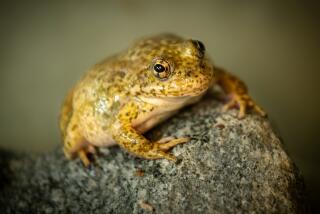Sun May Play Role in Frog Deformities
DULUTH, Minn. â As scientists search for what is causing deformed frogs in Minnesota and elsewhere in the country, some researchers say the abnormalities might be related to sunlight.
In laboratory experiments, scientists with the U.S. Environmental Protection Agency in Duluth have induced frog deformities by using ultraviolet radiation, raising the possibility that harmful components in sunlight might have caused abnormal limb development in thousands of frogs in the last three years.
The EPAâs findings are to be presented Thursday at a scientific symposium in San Francisco.
âWhen they started popping their limbs out, we saw some very interesting things that appeared to be related solely to the UV treatment,â said Gary Ankley, lead researcher on the project. âWe had everything in the experiment from absolutely no [hind] limbs to variations of digit deformities.â
Previously, the Minnesota Pollution Control Agency and the National Institute of Environmental Health Sciences announced that their preliminary research suggests that something in the water might be causing abnormalities. Other researchers have suggested that such things as parasites could be responsible.
Judy Helgen, a wetlands biologist with the Minnesota Pollution Control Agency, said there may be several causes for the assorted eye, leg and internal organ abnormalities that have been documented in frogs.
Ultraviolet radiation includes the high-energy, short wavelengths in sunlight. The rays are invisible but can cause biological damage at certain exposure levels.
In addition to concerns about increasing eye problems and skin cancer rates for humans, some biologists fear that even small extra doses of radiation at certain times of the year may be affecting plants, frogs and other sensitive wildlife species.
Scientists are especially concerned about very short wavelengths, known as UV-B radiation. Some have estimated that 10% to 15% more UV-B radiation is reaching the ground in places such as Minnesota in recent years because the protective ozone layer in the upper atmosphere has thinned.
Andrew Blaustein, a zoology professor at Oregon State University, said the EPA experiments corroborate his findings of correlations between ultraviolet radiation and frog egg mortality.
But Cynthia Carey, a University of Colorado biologist, said that if UV-B radiation is harming amphibians, scientists should see more problems at high altitudes, which hasnât happened.
*
John Moriarty, a herpetologist and wildlife specialist at Hennepin Parks, said that Minnesota frogs probably receive far less UV-B radiation in natural settings than they did in the Duluth lab.
âWhen tadpoles are out in the lakes and wetlands and ponds, they tend to be in areas with heavy vegetation where itâs shaded and much of the water is murky or tinted,â he said.
Ankley acknowledged that the water in the EPA experiment did not resemble that in breeding ponds, but he said that the lab controls for ultraviolet light were âa reasonably realistic exposure scenarioâ for developing frogs. The next step will be to design an outdoor experiment to test the UV-B theory further, he said.





